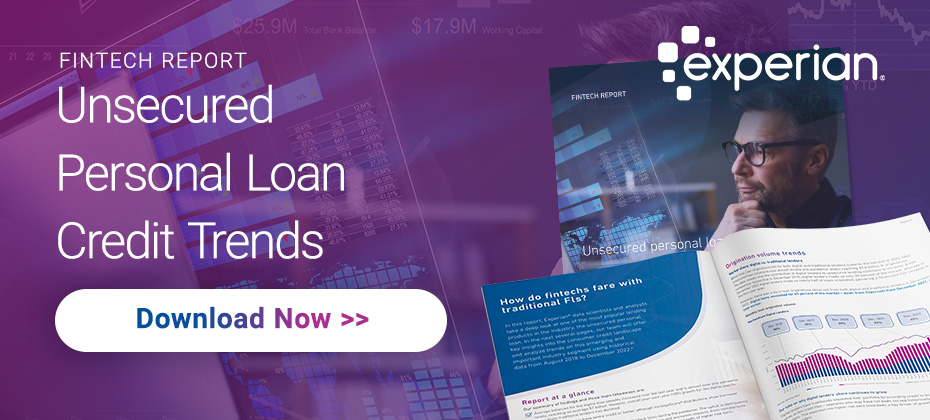Latest Posts

The unsecured personal loan, one of the most popular products in the financial space, has seen ebbs and flows over the last several years due to many factors, including economic volatility, the global pandemic, changing consumer behaviors and expectations, and more. Experian data scientists and analysts took a deep dive into data between 2018 and 2022 to uncover and analyze trends in this important industry segment. Additionally, they recommend fintech lending solutions to help fintechs stay ahead of ever-changing market conditions and discover new opportunities. This analysis shows that digital loans accounted for 45 percent of the market in 2022. While this is down from 52% in 2021, digital loan market share continues to grow. The analysis also provides a detailed look into who the digital borrower is and how they compare to traditional borrowers. As we look to the rest of 2023 and beyond, fintechs must be armed with the best digital lending technology, tools, and data to fuel profitable growth while mitigating as much risk as possible. Download our fintech trends report for a full analysis on origination volume trends, delinquency trends, and consumer behavior insights. Download now

Every data-driven organization needs to turn raw data into insights and, potentially, foresight. There was a time when lack of data was a hindrance, but that's often no longer the case. Many organizations are overwhelmed with too much data and lack clarity on how to best organize or use it. Modern business intelligence platforms can help. And financial institutions can use business intelligence analytics to optimize their decisioning and uncover safe growth opportunities. What is business intelligence? Business intelligence is an overarching term for the platforms and processes that organizations use to collect, store, analyze and display data and information. The ability to go from raw data to useful insights and foresight presents organizations with a powerful advantage, and can help them greatly improve their operations and efficiencies. Let’s pause and break down the below terms before expanding on business intelligence. Data: The raw information, such as customers' credit scores. Many organizations collect so much data that keeping it all can be an expensive challenge. Access to new types of data, such as alternative credit data, can assist with decisioning — but additional data points are only helpful if you have the resources or expertise to process and analyze them.Information: Once you process and organize data points, you can display the resulting information in reports, dashboards, and other visualizations that are easier to understand. Therefore, turning raw data into information. For example, the information you acquire might dictate that customers with credit scores over 720 prefer one of your products twice as much as your other products.Insight: The information tells you what happened, but you must analyze it to find useful and actionable insights. There could be several reasons customers within a specific score band prefer one product over another, and insights offer context and help you decide what to do next. In addition, you could also see what happened to the customers who were not approved.Foresight: You can also use information and insights to make predictions about what can happen or how to act in the future given different scenarios. For example, how your customers' preferences will likely change if you offer new terms, introduce a new product or there's a large economic shift. Business intelligence isn't new — but it is changing. Traditionally, business intelligence heavily relied on IT teams to sift through the data and generate reports, dashboards and other visualizations. Business leaders could ask questions and wait for the IT team to answer the queries and present the results. Modern business intelligence platforms make that process much easier and offer analytical insights. Now even non-technical business leaders can quickly answer questions with cloud-based and self-service tools. Business intelligence vs. business intelligence analytics Business intelligence can refer to the overall systems in place that collect, store, organize and visualize your data. Business intelligence tends to focus on turning data into presentable information and descriptive analytics — telling you what happened and how it happened. Business intelligence analytics is a subset of business intelligence that focuses on diagnostics, predictive and prescriptive analytics. In other words, why something happened, what could happen in the future, and what you should do. Essentially, the insights and foresight that are listed above. How can modern business intelligence benefit lenders? A business intelligence strategy and advanced analytics and modeling can help lenders precisely target customers, improve product offerings, streamline originations, manage portfolios and increase recovery rates. More specifically, business intelligence can help lenders uncover various trends and insights, such as: Changes in consumers' financial health and credit behavior.How customers' credit scores migrate over time.The risk performance of various portfolios.How product offerings and terms compare to competitors.Which loans are they losing to peers?Which credit attributes are most predictive for their target market? Understanding what's working well today is imperative. But your competitors aren't standing still. You also need to monitor trends and forecast the impact — good or bad — of various changes. WATCH: Webinar: Using Business Intelligence to Unlock Better Lending Decisions Using business intelligence to safely grow your portfolio Let's take a deeper dive into how business intelligence could help you grow your portfolio without taking on additional risk. It's an appealing goal that could be addressed in different ways depending on the underlying issue and business objective. For example, you might be losing loans to peers because of an acquisition strategy that's resulting in declining good customers. Or, perhaps your competitors' products are more appealing to your target customers. Business intelligence can show you how many applications you received, approved, and booked — and how many approved or declined applicants accepted a competitor's offer. You can segment and analyze the results based on the applicant’s credit scores, income, debt-to-income, loan amounts, loan terms, loan performance and other metrics. An in-depth analysis might highlight meaningful insights. For example, you might find that you disproportionately lost longer-term loans to competitors. Perhaps matching your competitors' long-term loan offerings could help you book more loans. READ: White paper: Getting AI-driven decisioning right in financial services Experian's business intelligence analytics solutions Lenders can use modern business intelligence platforms to better understand their customers, products, competitors, trends, and the potential impact of shifting economic circumstances or consumer behavior. Experian's Ascend Intelligence Services™ suite of solutions can help you turn data points into actionable insights. Ascend Intelligence Services™ Acquire Model: Create custom machine learning models that can incorporate internal, bureau and alternative credit data to more accurately assess risk and increase your lending universe.Ascend Intelligence Services™ Acquire Strategy: Get a more granular view of applicants that can help you improve segmentation and increase automation.Ascend Intelligence Services™ Pulse: A model and strategy health dashboard that can help you proactively identify and remediate issues and nimbly react to market changes.Ascend Intelligence Services™ Limit: Set and manage credit limits during account opening and when managing accounts to increase revenue and mitigate risk.Ascend Intelligence Services™ Foresight: A modern business intelligence platform that offers easy-to-use tools that help business leaders make better-informed decisions. Businesses can also leverage Experian's industry-leading data assets and expertise with various types of project-based and ongoing engagements. Learn more about how you can implement or benefit from business intelligence analytics.

The fraud problem is ever-present, with 94% of businesses reporting it as a top priority, and fraudsters constantly finding new targets for theft. Preventing fraud requires a carefully orchestrated strategy that can recognize and treat a variety of types — without adding so much friction that it drives customers away. Experian’s fraud prevention and detection platform, CrossCore®, was recently named an Overall Leader, Product Leader in Fraud Reduction Intelligence Platforms, Innovation Leader and Market Leader in Fraud Reduction by KuppingerCole. CrossCore is an integrated digital identity and fraud risk platform that enables organizations to connect, access, and orchestrate decisions that leverage multiple data sources and services. CrossCore combines risk-based authentication, identity proofing, and fraud detection into a single, state-of-the-art cloud platform. It engages flexible decisioning workflows and advanced analytics to make real-time risk decisions throughout the customer lifecycle. This recognition highlights Experian’s comprehensive approach to combating fraud and validates that CrossCore offers best-in-class capabilities by augmenting Experian’s industry-leading identity and fraud offerings with a highly curated ecosystem of partners which enables further optionality for organizations based on their specific needs. To learn more about how CrossCore can benefit your organization, read the report or visit us. Learn more

On average, the typical global consumer owns three or more connected devices.1 80% of consumers bounce between devices, while 31% who turned to digital channels for their last purchase used multiple devices along the way.2 Considering these trends, many lenders are leveraging multiple channels in addition to direct mail, including email and mobile applications, to maximize their credit marketing efforts. The challenge, however, is effectively engaging consumers without becoming overbearing or inconsistent. In this article, we explore what identity resolution for credit marketing is and how the right identity tools can enable financial institutions to create more cohesive and personalized customer interactions. What is identity resolution? Identity resolution connects unique identifiers across touchpoints to build a unified identity for an individual, household, or business. This requires an identity graph, a proprietary database that collects, stitches, and stores identifiers from digital and offline sources. As a result, organizations can create a persistent, high-definition customer view, allowing for more consistent and meaningful brand experiences. What are the types of identity resolution? There are two common approaches to identity resolution: probabilistic ID matching and deterministic ID matching. Probabilistic ID matching uses multiple algorithms and data sets to match identity profiles that are most likely the same customer. Data points used in probabilistic models include IP addresses and device types. Deterministic ID matching uses first-party data that customers have produced, enabling you to merge new data with customer records and identify matches among existing identifiers. Examples of this type of data include phone numbers and email addresses. What role does identity resolution play in credit marketing? Maintaining a comprehensive customer view is crucial to credit marketing — the insights gained allow lenders to determine who they should engage and the type of offer or messaging that would resonate most. But there are many factors that can prevent financial institutions from doing this effectively: poor data quality, consumers bouncing between multiple devices, and so on. Seven out of 10 consumers find it important that companies they interact with online identify them across visits. Identity resolution for credit marketing solves these issues by matching and linking customer data from disparate sources back to a single profile. This enables lenders to: Create highly targeted campaigns. If your data is incomplete or inaccurate, you may waste your marketing spend by engaging the wrong audience or sending out irrelevant credit offers. An identity resolution solution that leverages expansive, regularly updated data gives you access to high-definition views of individuals, resulting in more personalization and greater campaign engagement. Deliver seamless, omnichannel experiences. To further improve your credit marketing efforts, you’ll need to keep up with consumers not only as their needs or preferences change, but also as they move across channels and devices. Instead of creating multiple identity profiles for the same person, identity resolution can recognize an individual across touchpoints, allowing you to create consistent offers and cohesive experiences. Picking the right marketing identity resolution solution While the type of identity resolution for marketing solution can vary depending on your business’s goals and challenges, Experian can help you get started. To learn more, visit us today. 1 Global number of devices and connections per capita 2018-2023, Statista. 2 Cross Device Marketing - Statistics and Trends, Go-Globe.

Innovation and inspiration took center stage at Day 2 of Vision. Jennifer Schulz, CEO of Experian, North America opened the day with a look ahead at some of the solutions that are powering opportunities today and tomorrow. Sitting down with Robert Boxberger, President, Decision Analytics, and Scott Brown, President, Consumer Information Services, the group discussed key priorities for business innovation and the need to challenge the status quo. AI came up for discussion – as was no surprise – and while AI isn’t new, the newest versions are transformative. Whether it’s building a model a mile up (mid-flight), or continuously asking if solutions are “first, best or only,” innovation is part of Experian’s DNA as evidenced by two demos that took place on the main stage. Demo: Fraud Sandbox Fraud moves fast. A demo of the Fraud Sandbox showed the audience the importance of looking at consumer insights to pull back fraud signals. By leveraging the right fraud platform, you can turn insight into action. Working only with internal data is limiting, making it hard to detect fraud clusters and organizations open themselves up to millions of dollars in fraud; with external data it's easier to spot multiple uses of same information in multiple applications. Demo: Ascend Ops Ascend Ops connects data across different parts of the business and automates the process of model deployment so you can spend less time deploying and more time testing in market. Keynote: Alexis Ohanian Alexis Ohanian credits his success to a series of very fortunate events. The son and grandson of immigrants, Ohanian saw hustle, self-reliance and grit in his parents that he hopes his own children have. The innovator talked about how important timing is for entrepreneurs, discussing early ideas, starting Reddit and what he looks for in backing startups via his venture capitalist firm Seven Seven Six – named after 776 BCE, the year of the first Olympics. Ohanian also talked about the need to lean into AI – that it can make lean teams more efficient when you can automate to accomplish more, faster. It also enables humans to do work that is creative, strategic and empathetic, with a better quality of life. And to round it out, the self-proclaimed “business dad” talked about how having a bigger why – in the form of children – makes him better at his job. Keynote: Michael Strahan Michael Strahan shared a number of gridiron glory stories, the mental muscle it takes to get into the zone on game day, and the rolodex of injuries he had over the years – and how it taught him to look at people as individuals; an education in sociology. From his father he learned to talk about “when” rather than “if” and he’s developed a “keep going” mentality when it comes to everything he does. From clothing lines and skincare to management and production, Strahan says he’s committed to continuing to say yes and not be afraid of trying anything. Session highlights – day 2 Identity and fraud trends Current considerations that are top of mind for organizations include the speed of change, regulatory landscape, technology and the number of people online. Fraudsters are evolving faster than ever and are returning to the basics – think DDA fraud, check fraud and check washing. It is imperative to balance security with convenience and seamlessness as consumer expectations aren’t waning; therefore, it’s the business’ responsibility to meet and exceed customer expectations and to ultimately protect customers. Consumer credit trends and innovation Retailers and tech titans are pushing further into financial services. What separates them from the industry? People rave about brands more so than they do banks. The session delineated that digital transformation is not the digitization of what institutions were already doing. It requires a new way of thinking. Consumer privacy In 2023, 26 states have introduced comprehensive privacy legislation. It’s top of mind for consumers and top of mind for the government. Experian approaches privacy with strategies focused on security, accuracy, fairness, transparency and inclusion. Operational efficiency A panel of financial institutions experts discussed how they use analytics for operational efficiency. They talked about how they prioritize, the importance of the regulatory wrapper, and what differentiated their methods to reach success and make an impact. Fraud Organizations must consider the risks and rewards of their actions. It is critical to use analytics to stay agile and leverage owned and external data to make smart, fast and safe decisions. The action items for today’s organizations? Model, test, scale, repeat – scale your model based on your growth goals and expectations, and truly know your customer at every point of the interaction. That’s a wrap on Vision 2023. We can’t wait to build on this momentum and see the conversations we have in store next year!

Breaking down, rethinking, and optimizing your debt collection recovery process can be complicated — but you risk falling behind if you don't invest in your business. From managing live agents to unlocking the latest machine-learning models, there are different options and routes you can take to improve recovery rates. Debt collection challenges in 2023 Collection agencies have embraced digitization. The benefits are numerous — cost savings, streamlined processes, and improved compliance, to name a few. However, digital tools aren't cure-alls, and they can even create new challenges if you're not careful. Maintaining accurate consumer data: Quickly reaching consumers can be difficult during times of economic uncertainty. Increased access to data can help you overcome this challenge, but only if you can manage and understand the information. If you simply turn on the metaphorical data streams, you could find yourself drowning in duplicate and erroneous entries.Keeping up with rising delinquencies: Delinquency rates steadily rose throughout 2022.1 Although rates may level out for some types of accounts in 2023, collection agencies need a plan for dealing with the potential increased volume. At the same time, continued low unemployment rates could make it difficult to hire and retain agents. Managing a tight budget: Recession worries also have companies rethinking expenses, which can impact your ability to increase head count and invest in technology. Finding effective trade-offs is going to be important for debt collection process optimization.Staying compliant: We've seen some major changes over the last few years, but there's no time to rest — debt collectors always need to be aware of new state and federal regulations. Digitization might make compliance more difficult if you're now managing an increasing amount of personal information or using text messages (or other omni-channels) to contact consumers. WATCH:Keeping pace with collections compliance changes Five ways to enhance your debt collection process Here are five ways that debt collectors can overcome today's challenges and take advantage of new opportunities. 1. Leverage clean data Continuously updating and checking the accuracy of your data can help increase right-party contact rates. But don't rely on your internal data and basic internet searches or public records. Leading data and skip-tracing services can give you access to additional data from credit bureaus, alternative financial services, collateral records, business listings and other helpful sources. Some skip-tracing tools can continuously verify and update contact information. They can also rank contact records, such as phone numbers, to save your agent's time. And identify consumers in a protected status such as bankrupt, deceased, and active military) and require special handling to help you stay compliant. 2. Implement advanced analytics and automation High-quality data can also be the foundation for a data-driven approach to collections. Use collections-specific models: Although credit risk scores can be a piece of the debt collection puzzle, debt collection recovery models are often a better fit. You may be able to use different models to score accounts based on exposure, risk, willingness to pay or behavioral factors. Segment accounts: Increased insights and models also allow you to more precisely segment accounts, which can help you handle larger volumes with fewer resources. For instance, you can more accurately determine which accounts require an agent's personal touch, which can move forward with an automated experience and which should go to the back of your queue. The data-driven approach also allows you to increasingly automate your collections — which can help you deal with rising delinquency rates in the face of a tight labor market and budget constraints. 3. Know when and how to make contact Segmentation and advanced analytics can tell you who and when to contact, but you also have to be mindful of how you reach out. Letters, calls, emails and texts can all be effective in the right circumstances, but no single option will always be best. For example, a text could be ideal when contacting Gen Z, but a call might work best for Baby Boomers. That's neither novel nor surprising, but it is important to stay up to date with the latest trends and preferences. Ideally, you reach people on their preferred channel at an appropriate time. You may also need to continually test, monitor and refine your process, especially if you want to increase automation. READ:Digital Debt Collection Future white paper 4. Offer financially appropriate treatments In addition to picking the right communication channel, consider the payment options you offer consumers. Various payment plans, settlements and policies can directly affect your recovery rates — and what performed best in previous years might not make sense anymore. Chatbots and virtual negotiators can also help improve recovery rates without straining your agents' time. And for accounts that will likely self-cure, automated texts or emails with links to self-service portals could be an ideal solution. Expanding payment methods, such as accepting payments from digital wallets when you're sending a text message, could also make sense. However, you want to be sure you're not wasting time or money by contacting consumers who don't have the means to make a payment. Instead, set those accounts aside for now, but monitor them for changes that could indicate their financial situation has changed — such as a new credit line. Then, try to offer a solution that will likely fit the consumer's circumstances. 5. Invest in your live agents Modern debt management and collection systems focus on digitization and automation, and these can improve recovery rates. But don't forget about your front-line agents. There will always be times when a personal touch gets you further than an automated message. Continued training and ongoing recognition can be important for retaining top performers, maintaining compliance and increasing agents' effectiveness. Partner for success Implementing an efficient and effective collections strategy can require a lot of work, but you don't have to go at it alone. Experian offers various debt collection solutions that can help optimize processes and free up your organization's resources and agents' time. Tap into our industry-leading data sources — including traditional credit data, alternative financial data and over 5,000 local phone exchange carriers — to find, update and verify account information. Available on the cloud or with secure file transfers, the TrueTrace™ and TrueTrace Live™ tools have led to a 10 percent lift in right-party contact rates compared to competitors. When it comes to optimizing outreach, you can prioritize accounts with over 60 industry-specific debt recovery scores via PriorityScore for CollectionsSM. Or work with Experian to create custom models for your organization. For an end-to-end decisioning solution, our AI-driven PowerCurve® Collections solution draws from internal and external data to determine the proper customer contact frequency, channel and treatment options, including self-service portals. Create your own strategies and workflows and manage the entire process with a single dashboard, cloud-based access and integrated reports. Learn more about Experian's debt collection process solutions 1Experian. (February 2023). Credit Scores Steady as Consumer Debt Balances Rise in 2022

Jennifer Schulz, CEO of Experian, North America kicked off Experian’s annual Vision conference Tuesday morning pointing to data, analytics, technology and collective curiosity as the drivers for change and a more impactful tomorrow to more than 700 attendees. Keynote speaker: Jennifer Bailey Jennifer Bailey, Vice President of Apple Pay and Apple Wallet, spoke about the customer experience “ethos.” She explained how Apple takes a long-term view and values the single most important performance metric as customer experience. She said creating a seamless customer experience comes down to making things simple and understandable, and asking, “Are we solving a customer problem?” and “How are we making it easier for customers to enjoy and liver their lives. Bailey, who said of all apps she uses the weather app the most, also talked about innovation, and that both intent and making mistakes are important parts of the process. Apple’s products are known for their user-friendliness, and design is part of that. She encouraged the audience to give design teams room to create without bottom line pressures and not to be afraid to take well-considered risks. Keynote Speaker: Gary Cohn Gary Cohn, Vice Chairman of IBM, talked about the current economic climate, and while it’s a natural viewpoint to look to the past for guidance, the current environment is unlike any before. Cohn discussed regulatory compliance in the banking industry and prioritizing safety and soundness. While AI is topical and in numerous headlines recently, Cohn reminded the conference goers that AI isn’t new. He said what is new and important is that you can now teach models to find the information needed rather than having to feed all the information yourself. He believes AI is not the end of employment, but rather helps boost productivity, efficiency, and job satisfaction and provides organizations more data. As for advice for the audience, Cohn shared opportunities are in the uncomfortable zones and you have to be willing to fail in order to succeed. Session highlights – Day 1 The conference hall was buzzing with conversations, discussions and thought leadership. Overall themes that were frequently part of the conversation included seamless customer experiences, agility in face of economic changes and leveraging AI/ML into strategies. Fraud automation and preventing commercial fraud More businesses are opening than ever before and lenders and service providers need a way to determine risk from businesses who are less than a year old. There is no one-size-fits-all approach to fraud. A layered solution assesses risk and applies the correct friction to resolve the risk and pass or refer the applicant. Identity Today’s consumer wants a personalized experience and is privacy conscious. Additionally, regulators are also pushing for greater privacy. Clean rooms allow you and a partner to add data to a safe space and learn more about consumers without exposing data. The right data improves acquisition rates, identity verification and allows you to anticipate customer needs. Advanced scoring Data, models and strategy are the levers institutions are using to leverage responsible analytics to meet their objectives like safely growing existing portfolios, managing the “right” level of risk, and providing a seamless digital experience. However, the total value of a decisioning system is almost always constrained by its most rudimentary component. The panel of experts discussed their uses and goals for leveraging models and customer experience was at the top of their priorities. Recession preparedness Delinquency is on the rise and lending offers made continue to drop. Changes in the economic climate require frequent monitoring of portfolio and decisions, benchmarking against peers, updating credit models and decision strategies, and stress testing portfolio and models. Trends in credit risk management While AI at the hands of everyone is topical today, it ranked lowest on the list of trends attendees believed were impacting their business. At the top of the list? The growing demand for simpler, faster and seamless experiences. More insights from Vision to come. Follow @ExperianVision and @ExperianInsights to see more of the action.

To reach customers in our modern, diverse communications landscape, it's not enough to send out one-size-fits-all marketing messages. Today's consumers value and continue to do business with organizations that put them first. For financial institutions, this means providing personalized experiences that enable your customers to feel seen and your marketing dollars to go further. How can you achieve this? The answer is simple: a customer-driven credit marketing strategy. What is customer-driven marketing? Customer-driven marketing is a strategy that focuses on putting consumers first, rather than products. It means thinking about the needs, wants and motivations of the prospects you're trying to reach and centering your marketing campaigns and messages around that audience. When done well, this comprehensive approach extends beyond the marketing team to all members of a company. The benefits of customer-driven credit marketing One benefit of this type of personalized credit marketing is that you can target customers with a potentially higher lifetime value. By focusing your marketing efforts on the right prospects, you'll ensure that budgets are being spent wisely and that you're not wasting valuable marketing dollars communicating with consumers who either won't respond or aren't a fit for your business. Customer-driven marketing enables you to identify and reach the most profitable, highly responsive prospects in the most efficient way, while also engaging with current customers to optimize retention rates. When you create marketing programs that are customer-driven, you're not just selling; you're building relationships. Rather than being simply a service provider, you become a trusted financial partner and advisor. This kind of data-driven customer experience can help you onboard more customers and retain them for longer, translating to better results when it comes to your bottom line. Customer-driven marketing: How to get started Customer-driven marketing is less funnel, more spiral. You research, test, refine and repeat, all while taking into account customer feedback and campaign results. It starts with defining your target audience and creating customer personas. As you do this, think about all the factors that are involved in your target customers’ path to purchase, from general awareness and growing need to the final motivation that pushes them to commit. You'll also want to consider what their pain points may be and the barriers that may prevent them from buying. Next, develop a marketing strategy that aligns with your target customers' needs and outlines how and where you'll reach them. It may also be helpful to gather and respond to customer feedback to ensure the value propositions in your campaigns are aligned with customer expectations. These insights can help you refine your messaging, resulting in increased response and retention rates. Use the right data to extend relevant credit offers When you send credit offers, you want to ensure they're reaching the right prospects at the right time. You also want to make sure these credit offers are relevant to the consumers that receive them. That's where quality data comes in. By optimizing your data-driven customer segmentation, you can develop timely and personalized credit offers to boost response rates. For example, you might have a target audience of consumers who are both creditworthy and looking for a new vehicle. Segmenting this audience into smaller groups by demographic, life stage, financial and other factors helps you create credit marketing campaigns that speak to each type of customer as an individual, not just a number. Meet consumers on their preferred channels Nowadays, consumer behavior is more fragmented than ever. This is relevant not just from a demographic point of view, but from the perspective of purchasing behavior. Customer-driven marketing helps you interact with prospects as individuals so that the value propositions they encounter are a true fit for their life situation. For instance, different age groups tend to spend time on different platforms. But why they're on those channels at any particular time matters too. Messaging aimed at prospects in their leisure time should be different from messaging they'll encounter when actively researching potential purchases. Keep up with your customers This is one answer to the question of how to improve customer retention as well. Research demonstrates that it's more cost-effective to keep a customer than to acquire a new one. When you tailor retention efforts with a well-thought-out customer-driven marketing strategy, you're likely to boost retention rates, which in many cases lead to better profits over time. Importance of a customer-driven marketing strategy Putting consumers at the center of credit marketing strategies — and at the center of your business as a whole — is the foundation for personalized experiences that can ultimately increase response rates and customer satisfaction. For more on how your organization can develop an effective customer-driven marketing strategy, learn about our credit marketing solutions.

A funnel describes marketing and sales opportunities because it is the widest at the top and narrowest at the bottom. This is an accurate representation because only a fraction of consumers who enter a sales funnel will become buyers. At the top of the funnel, you find consumers exploring and learning about purchase options. These consumers respond to awareness-based marketing regarding vehicle features or comparisons. They are not typically focused on pricing but rather just learning about options. In the middle of the funnel is where you find customers getting closer to a vehicle purchase. They are evaluating their options, including new versus used, and exploring specific units on consumer sites. These consumers have moved beyond general market awareness and vehicle feature interest and into evaluating what vehicle features meet their needs and what price range and financing options may best suit their budget. During this time, marketing and sales contacts with specific incentives or vehicles of interest-based marketing are effective. Nearing the lower funnel As you near the lower funnel, you will find consumers who are initiating the process with the intent to purchase. These consumers are visiting consumer shopping sites for used vehicle research as well as dealer websites. Used vehicle consumers are visiting Vehicle Detail Pages (VDPs) and viewing vehicle history reports. These lower funnel consumers are exploring trade-in values and trying to put together their vehicle sale and purchase plan. There are many ways lower funnel opportunities interact with the automotive ecosystem. With improvements in digital retailing even when just one small part of the sales process is initiated prior to the consumer visiting the brick-and-mortar store, dealers have an opportunity to capture these lower-funnel consumers. Some effective examples include quick “sell your trade” links or prequalification links on web pages that allow consumers to obtain trade values/trade offers and, in some cases, to get full prequalification for loans. Often these digital retailing features are able to track and communicate to dealers about these lower funnel and fully engaged consumers. Take advantage of lower funnel leads with digital retailing tools As online digital retailing steps become more commonplace, dealers will find themselves leveraging these leads for sales. Utilizing effective, consumer-friendly, and secure functions that allow consumers to access or work through the components of a sale will maximize engagement. Keeping consumers tied to your website during the process can keep them working with your dealership processes. To learn how Experian Automotive can help you gain lower funnel opportunities, contact Mike Costanzo.

In previous posts, I’ve explored the potential ramifications of the end of the Public Health Emergency (PHE) and how it will impact agency plans such as Medicaid eligibility redeterminations. Many states may have already prepared a risk-based approach to address the unwinding process. States need to balance these plans with onboarding new applicants and maintaining the service levels required by the Centers for Medicare & Medicaid Services (CMS). Regardless of the approach, states should look for efficiency in all aspects of the redeterminations process, including aligning pending work with other program recertifications and maximizing the use of available information and tools. What does the end of the PHE mean for state agencies? From the end of the PHE, state agencies will have 12 months to initiate all citizen eligibility renewals and a total of 14 months to complete them. States may begin the unwinding process 60 days prior to the month in which the PHE ends. Many states have already begun Medicaid eligibility redeterminations in an effort to meet this deadline. CMS has provided extensive guidance in their Planning for Resumption document, which state agencies can refer to for full details. Building a proper redeterminations plan Redeterminations plans should verify citizen information with all available information, including residency, age, income, and deceased status. These plans should also support the assessment of identity risk and have the ability to ensure continuous outreach with accurate mailing addresses, phone numbers for calls and texts, email addresses, and assessments of returned mail. CMS guidance encourages states to verify eligibility requirements by mail, email, and other communications channels while minimizing the amount of time and documentation required of beneficiaries. The benefit of standing up this structure? More effective day-forward solutions that can help agencies assess any new and ongoing benefits requests and maintain accurate eligibility lists. How can Experian help? Experian® has a range of products designed to help organizations verify contact information, such as phone numbers and mailing addresses, as well as income and employment. Our exclusive income and employment data can be leveraged incrementally in non-automated verification methods so that individuals not found by other services can be processed quickly via batch processing — minimizing any impact to beneficiaries while improving overall program performance. Our address verification tools provide improved outreach to beneficiaries with the best and most accurate mailing addresses, leveraging the National Change of Address (NCOA) database, as well as phone number information. The phone number information includes a mobile phone indicator, enabling text message outreach. Additionally, Experian can provide email address provisioning to verify or provide email addresses, which creates another path for contact. All of this helps agencies develop better redeterminations plans to manage the end of the PHE, and better process future benefits requests. To learn more about how we can help, visit us or request a call.

The science of turning historical data into actionable insights is far from magic. And while organizations have successfully used predictive analytics for years, we're in the midst of a transformation. New tools, vast amounts of data, enhanced computing power and decreasing implementation costs are making predictive analytics increasingly accessible. And business leaders from varying industries and functions can now use the outcomes to make strategic decisions and manage risk. What is predictive analytics? Predictive analytics is a type of data analytics that uses statistical modeling and machine learning techniques to make predictions based on historical data. Organizations can use predictive analytics to predict risks, needs and outcomes. You might use predictive analytics to make an immediate decision. For example, whether or not to approve a new credit application based on a credit score — the output from a predictive credit risk model. But organizations can also use predictive analytics to make long-term decisions, such as how much inventory to order or staff to hire based on expected demand. How can predictive business analytics help a business succeed? Businesses can use predictive analytics in different parts of their organizations to answer common and critical questions. These include forecasting market trends, inventory and staffing needs, sales and risk. With a wide range of potential applications, it’s no surprise that organizations across industries and functions are using predictive analytics to inform their decisions. Here are a few examples of how predictive analytics can be helpful: Financial services: Financial institutions can use predictive analytics to assess credit risk, detect fraudulent applicants or transactions, cross-sell customers and limit losses during recovery. Healthcare: Using data from health records and medical devices, predictive models can predict patient outcomes or identify patients who need critical care. Manufacturing: An organization can use models to predict when machines need to be turned off or repaired to improve their longevity and avoid accidents. Retail: Brick-and-mortar retailers might use predictive analytics when deciding where to expand, what to cross-sell loyalty program members and how to improve pricing. Hospitality: A large hospitality group might predict future reservations to help determine how much staff they need to hire or schedule. Advanced techniques in predictive modeling for financial services Emerging technologies, particularly AI and machine learning (ML), are revolutionizing predictive modeling in the financial sector by providing more accurate, faster and more nuanced insights. Taking a closer look at financial services, consider how an organization might use predictive credit analytics and credit risk scores across the customer lifecycle. Marketing: Segment consumers to run targeted marketing campaigns and send prescreened credit offers to the people who are most likely to respond. AI models can analyze customer data to offer personalized offers and product recommendations. Underwriting: AI technologies enable real-time data analysis, which is critical for underwriting. The outputs from credit risk models can help you to quickly approve, deny or send applications for manual review. Explainable machine learning models may be able to expand automation and outperform predictive models built with older techniques by 10 to 15 percent.1 Fraud detection models can also raise red flags based on suspicious information or behaviors. Account management: Manage portfolios and improve customer retention, experience and lifetime value. The outputs can help you determine when you should adjust credit lines and interest rates or extend offers to existing customers. AI can automate complex decision-making processes by learning from historical data, reducing the need for human intervention and minimizing human error. Collections: Optimize and automate collections based on models' predictions about consumers' propensity to pay and expected recovery amounts. ML models, which are capable of processing vast amounts of unstructured data, can uncover complex patterns that traditional models might miss. Although some businesses can use unsupervised or “black box" models, regulations may limit how financial institutions can use predictive analytics to make lending decisions. Fortunately, there are ways to use advanced analytics, including AI and ML, to improve performance with fully compliant and explainable credit risk models and scores. WHITE PAPER: Getting AI-driven decisioning right in financial services Developing predictive analytics models Going from historical data to actionable analytics insights can be a long journey. And if you're making major decisions based on a model's predictions, you need to be confident that there aren’t any missteps along the way. Internal and external data scientists can oversee the process of developing, testing and implementing predictive analytics models: Define your goal: Determine the predictions you want to make or problems you want to solve given the constraints you must act within. Collect data: Identify internal and external data sources that house information that could be potentially relevant to your goal. Prepare the data: Clean the data to prepare it for analysis by removing errors or outliers and determining if more data will be helpful. Develop and validate models: Create predictive models based on your data, desired outcomes and regulatory requirements. Deciding which tools and techniques to use during model development is part of the art that goes into the science of predictive analytics. You can then validate models to confirm that they accurately predict outcomes. Deploy the models: Once a model is validated, deploy it into a live environment to start making predictions. Depending on your IT environment, business leaders may be able to easily access the outputs using a dashboard, app or website. Monitor results: Test and monitor the model to ensure it's continually meeting performance expectations. You may need to regularly retrain or redevelop models using training data that better reflects current conditions. Depending on your goals and resources, you may want to start with off-the-shelf predictive models that can offer immediate insights. But if your resources and experience allow, custom models may offer more insights. CASE STUDY: Experian worked with one of the largest retail credit card issuers to develop a custom acquisition model. The client's goal was to quickly replace their outdated custom model while complying with their model governance requirements. By using proprietary attribute sets and a patented advanced model development process, Experian built a model that offered 10 percent performance improvements across segments. Predictive modeling techniques Data scientists can use different modeling techniques when building predictive models, including: Regression analysis: A traditional approach that identifies the most important relationships between two or more variables. Decision trees: Tree-like diagrams show potential choices and their outcomes. Gradient-boosted trees: Builds on the output from individual decision trees to train more predictive trees by identifying and correcting errors. Random forest: Uses multiple decision trees that are built in parallel on slightly different subsets of the training data. Each tree will give an output, and the forest can analyze all of these outputs to determine the most likely result. Neural networks: Designed to mimic how the brain works to find underlying relationships between data points through repeated tests and pattern recognition. Support vector machines: A type of machine learning algorithm that can classify data into different groups and make predictions based on shared characteristics. Experienced data scientists may know which techniques will work well for specific business needs. However, developing and comparing several models using different techniques can help determine the best fit. Implementation challenges and solutions in predictive analytics Integrating predictive analytics into existing systems presents several challenges that range from technical hurdles to external scrutiny. Here are some common obstacles and practical solutions: Data integration and quality: Existing systems often comprise disparate data sources, including legacy systems that do not easily interact. Extracting high-quality data from these varied sources is a challenge due to inconsistent data formats and quality. Implementing robust data management practices, such as data warehousing and data governance frameworks, ensure data quality and consistency. The use of APIs can facilitate seamless data integration. Scalability: Predictive business analytics models that perform well in a controlled test environment may not scale effectively across the entire organization. They can suffer from performance issues when deployed on a larger scale due to increased data volumes and transaction rates. Invest in scalable infrastructure, such as cloud-based platforms that can dynamically adjust resources based on demand. Regulatory compliance: Financial institutions are heavily regulated, and any analytics tool must comply with existing laws — such as the Fair Credit Reporting Act in the U.S. — which govern data privacy and model transparency. Including explainable AI capabilities helps to ensure transparency and compliance in your predictive models. Compliance protocols should be regularly reviewed to align with both internal audits and external regulations. Expertise: Predictive analytics requires specialized knowledge in data science, machine learning and analytics. Develop in-house expertise through training and development programs or consider partnerships with analytics firms to bridge the gap. By addressing these challenges with thoughtful strategies, organizations can effectively integrate predictive analytics into their systems to enhance decision-making and gain a competitive advantage. From prediction to prescription While prediction analytics focuses on predicting what may happen, prescription analytics focuses on what you should do next. When combined, you can use the results to optimize decisions throughout your organization. But it all starts with good data and prediction models. Learn more about Experian's predictive modeling solutions. 1Experian (2020). Machine Learning Decisions in Milliseconds *This article includes content created by an AI language model and is intended to provide general information.

Despite economic uncertainty, new-customer acquisition remains a high priority in the banking industry, especially with increasing competition from fintech and big tech companies. For traditional banks, standing out in this saturated market doesn’t just involve enhancing their processes — it requires investing in the future of their business: Generation Z. Explore what Gen Z wants from financial technology and how to win them over in 2023 and beyond: Accelerate your digital transformation As digital natives, many Gen Zers prefer interacting with their peers and businesses online. In fact, more than 70% of Gen Zers would consider switching to a financial services provider with better digital offerings and capabilities.1 With a credit prescreen solution that harnesses the power of digital engagement, you can extend and represent firm credit offers through your online and mobile banking platforms, allowing for greater campaign reach and more personalized digital interactions. READ: Case study: Drive loan growth with digital prescreen Streamline your customer onboarding process With 70% of Gen Z and millennials having already opened an account online, it’s imperative that financial institutions offer a digital onboarding experience that’s quick, intuitive, and seamless. However, 44% of Gen Z and millennials state that their digital customer experience has been merely average, noting that the biggest gaps exist in onboarding and account opening.2 To improve the onboarding process, consider leveraging a flexible decisioning platform that accepts applications from multiple channels and automates data collection and identity verification. This way, you can reduce manual activity, drive faster decisions, and provide a frictionless digital customer experience. WATCH: OneAZ Credit Union saw a 25% decrease in manual reviews after implementing an integrated decisioning system Provide educational tools and resources Many Gen Zers feel uncertain and anxious about their financial futures, with their top concern being the cost of living. One way to empower this cohort is by offering credit education tools like step-by-step guides, score simulators, and credit alerts. These resources enable Gen Z to better understand their credit and how certain choices can impact their score. As a result, they can establish healthy financial habits, monitor their progress, and gain more control of their financial lives. By helping Gen Z achieve financial wellness, you can establish trust and long-lasting relationships, ultimately leading to higher customer retention and increased revenue for your business. To learn how Experian can help you engage the next generation of consumers, check out our credit marketing solutions. Learn more 1Addressing banking’s key business challenges in 2023.

The rise of the digital channel lead to a rise in new types of fraud – like cryptocurrency and buy now, pay later scams. While the scams themselves are new, they’re based on tried-and-true schemes like account takeover and synthetic identity fraud that organizations have been working to thwart for years, once again driving home the need for a robust fraud solution. While the digital channel is extremely attractive to many consumers due to convenience, it represents a balancing act for organizations – especially those with outdated fraud programs who are at increased risk for fraud. As organizations look for ways to keep themselves and the consumers they serve safe, many turn to fraud risk mitigation. What are fraud risk management strategies? Fraud risk management is the process of identifying, understanding, and responding to fraud risks. Proper fraud risk management strategies involve creating a program that detects and prevents fraudulent activity and reduces the risks associated with fraud. Many fraud risk management strategies are built on five principles: Fraud Risk AssessmentFraud Risk GovernanceFraud PreventionFraud DetectionMonitoring and Reporting By understanding these principles, you can build an effective strategy that meets consumer expectations and protects your business. Fraud risk assessment Fraud protection begins with an understanding of your organization’s vulnerabilities. Review your top risk areas and consider the potential losses you could face. Then look at what controls you currently have in place and how you can dial those up or down to impact both risk and customer experience. Fraud risk governance Fraud risk governance generally takes the form of a program encompassing the structure of rules, practices, and processes that surround fraud risk management. This program should include the fraud risk assessment, the roles and responsibilities of various departments, procedures for fraud events, and the plan for on-going monitoring. Fraud prevention “An ounce of prevention is worth a pound of cure.” This adage certainly rings true when it comes to fraud risk management. Having the right controls and procedures in place can help organizations stop a multitude of fraud types before they even get a foot in the door. Account takeover fraud prevention is an ideal example of how organizations can keep themselves and consumers safe. Fraud detection The only way to stop 100% of fraud is to stop 100% of interactions. Since that’s not a sustainable way to run a business, it’s important to have tools in place to detect fraud that’s already entered your ecosystem so you can stop it before damage occurs. These tools should monitor your systems to look for anomalies and risky behaviors and have a way to flag and report suspicious activity. Monitoring and reporting Once your fraud detection system is in place, you need active monitoring and reporting set up. Some fraud detection tools may include automatic next steps for suspicious activity such as step-up authentication or another risk mitigation technique. In other cases, you’ll need to get a person involved. In these cases it’s critical to have documented procedure and routing in place to ensure that potential fraud is assessed and addressed in a timely fashion. How to implement fraud risk management By adhering to the principles above, you can gain a holistic view of your current risk level, determine where you want your risk level to be, and what changes you’ll need to make to get there. While you might already have some of the necessary tools in place, the right next step is usually finding a trusted partner who can help you review your current state and help you use the right fraud prevention services that fit your risk tolerance and customer experience goals. To learn more about how Experian can help you leverage fraud prevention solutions, visit us or request a call. Learn more

With nearly seven billion credit card and personal loan acquisition mailers sent out last year, consumers are persistently targeted with pre-approved offers, making it critical for credit unions to deliver the right offer to the right person, at the right time. How WSECU is enhancing the lending experience As the second-largest credit union in the state of Washington, Washington State Employees Credit Union (WSECU) wanted to digitalize their credit decisioning and prequalification process through their new online banking platform, while also providing members with their individual, real-time credit score. WSECU implemented an instant credit decisioning solution delivered via Experian’s Decisioning as a ServiceSM environment, an integrated decisioning system that provides clients with access to data, attributes, scores and analytics to improve decisioning across the customer life cycle. Streamlined processes lead to upsurge in revenue growth Within three months of leveraging Experian’s solution, WSECU saw more members beginning their lending journey through a digital channel than ever before, leading to a 25% increase in loan and credit applications. Additionally, member satisfaction increased with 90% of members finding the simplified process to be more efficient and requiring “low effort.” Read our case study for more insight on using our digital credit solutions to: Prequalify members in real-time at point of contact Match members to the right loan products Increase qualification, approval and take rates Lower operational and manual review costs Read case study

BNPL is a misunderstood form of credit. In fact, many consumers are unaware that it is credit at all and view it simply as a mode of payment. This guide debunks common BNPL myths to explain what BNPL data will mean for lenders and consumers. In the past year, Experian collected more than 130 million buy now, pay later (BNPL) records from four major BNPL fintech lenders and conducted the most comprehensive analysis of BNPL data available today. The results provided valuable insights on: Who are the consumers using BNPL loans? What is the nature of their current mainstream credit relationships? What do their current BNPL behaviors look like? BNPL myth-busting: Who’s using it, how much are they spending and how risky are BNPL loans? Since BNPL launched in the United States in the 2010s, BNPL has exploded into the consciousness of online shoppers, especially during the COVID-19 pandemic. According to Forrester, Millennials are the biggest adopters of BNPL at 18%, followed by their younger counterparts in Gen Z at 11%.1 But looking at statistics like these without additional analysis could be problematic. The dramatic growth of leading BNPL fintechs such as Klarna, Affirm and Afterpay has demonstrated how strongly these services resonate with consumers and retailers. The growth of BNPL has attracted the attention of established lenders interested in capitalizing on the popularity of these services (while also looking to minimize its impact on their existing services, such as credit cards or personal loans). Meanwhile, the Consumer Financial Protection Bureau (CFPB) has urged caution about potential risks, calling for more consistent consumer protections market-wide and transparency into consumer debt accumulation and overextension across lenders. The underlying assumptions debated are that BNPL is used: Predominantly by young people with limited incomes and credit history To pay for frequent, low-value purchases using a cheap and readily available source of credit As a result, it is often seen as a riskier form of lending. But are these assumptions correct? Using data from more than 130 million BNPL transactions from four leading BNPL fintech lenders, we’ve obtained a more detailed and comprehensive understanding of BNPL users and their defining features. Our findings look somewhat different to the popular stereotypes. Myth 1: BNPL is used only for low-value purchases According to our analysis, most BNPL purchases, 95 percent are for items costing $300 or less.2 Some of it is low-value, but not all. In fact, we found that the average purchase using BNPL was similar to that of a credit card, at $132.Average transaction sizes have increased 10 percent year-over-year, and we now see BNPL purchases for goods costing well over $1,000. We also see that consumers take out an average of 5 BNPL loans in a year and 23 percent of them have loans with more than one BNPL provider at a time. Myth 2: BNPL is simply an easier payment method Consumers see BNPL as a simple, quick and convenient way to pay. But, as shoppers receive goods for which payment is deferred, it’s also a form of credit. However, unlike short-term high-interest loans, BNPL credit comes at zero cost to the borrower, with some, but not all BNPL fintech providers charging late payment fees – fueling many borrowers’ sense that it’s an easy way to pay, rather than a loan. Myth 3: Only Gen Z shoppers aged 25 and below are using BNPL Younger shoppers are slightly more represented in the data transactions, but our analysis shows consumers of all ages use BNPL. BNPL is going mainstream, and its appeal is widening. The average age of BNPL consumers is 36 years old, with an average credit history of 9 years.2 The ease of use of these services at the checkout means they have a broad appeal. Over half of U.S. adults have reported using a BNPL service at least once. Despite Millennials and Gen Z having used BNPL financing the most, Gen Xers are not too far behind in usage, with 52% having used it.2 We anticipate that in the use of BNPL will continue to grow as more customers become more familiar with the benefits, and the diversification of products continues. Understanding the opportunities this growth presents to both consumers and lenders is critical to protecting their interests. And helping to facilitate access to credit, enabling responsible spending, while also limiting risks and providing services that consumers can afford is also critical. Download the full guide for additional myths we’re exposing We will take a deep dive into what our early data analysis suggests about the market and the BNPL myths our analysis is exposing. Additionally, we will examine: Why BNPL data matters to providers and lenders How BNPL data can improve visibility of consumers’ creditworthiness Ways in which transparency of BNPL data could benefit consumers 1The Buy Now, Pay Later (BNPL) Opportunity,” Forrester Report, April 29, 2022.2Experian data and analytics derived from 130M+ BNPL transactions